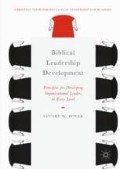Abstract
The final chapter details aspects of conflict reduction and peace multiplication. The results of mining Exodus 18 reveal Moses providing leadership development and discipleship toward followers, which takes place through a social atmosphere akin to a loving, trusting, functional family. The element of trust is employed, which remains a central factor, particularly within the focus and complexities of group life. Another factor considered is individual identity as related to group life, adding toward the complexity of group life. The result of theses factors is often group conflict. Group conflict need not remain a destructive force, but rather a force for good. Finally a single-shot case study is included, which is a report of leadership/follower findings, specifically that of ethical leader/follower relations. The case study employed a qualitative phenomenological approach toward ethical leader followership to explain insider perspective and practice concerning trust, the outcome including conflict reduction and peace multiplication.
Access this chapter
Tax calculation will be finalised at checkout
Purchases are for personal use only
References
Alderfer, C. P. (1995). Staff Authority and Leadership in Experiential Groups. In J. Gillette & M. McCollom (Eds.), Groups in Context: A New Perspective on Group Dynamics (pp. 252–275). Lanham, MD: University Press of America Inc.
Barentsen, J. (2011). Emerging Leadership in the Pauline Mission: A Social Identity Perspective on Local Leadership Development in Corinth and Ephesus. Eugene, OR: Pickwick Publications.
Boal, K. B., & Schultz, P. L. (2007, August). Storytelling, Time, and Evolution: The Role of Strategic Leadership in Complex Adaptive Systems, The Leadership Quarterly, 18(4), 411–428. ISSN 1048-9843. http://0-dx.doi.org.library.regent.edu/10.1016/j.leaqua.2007.04.008 (http://0-www.sciencedirect.com.library.regent.edu/science/article/pii/S1048984307000744).
Edmund, L. (2010). Interdisciplinary Group Conflict Diagnosis and Intervention: Exploration of Conflict Intensity and Effective Conflict Resolution Methods. International Journal Of Interdisciplinary Social Sciences, 4(12), 35–44.
Hatch, M. J., & Cunliffe, A. L. (2006). Organization Theory: Modern, Symbolic, and Postmodern Perspectives (2nd ed.). New York, NY: Oxford University Press.
Ivancevich, J., & Konopaske, R. (2010). Organizational Behavior (9th ed.). New York: McGraw-Hill.
Javidan, M., & House, R. J. (2001). Cultural Acumen for the Global Manager: Lessons from Project GLOBE. Organizational Dynamics, 29(4), 289–305. Retrieved from http://eres.regent.edu:2048/login? (http://search.ebscohost.com/login.aspx?direct=true&db=bth&AN=6613478&site=bsi-live).
Klein, E. B. (1995). Teaching Group Dynamics as a Visitor: Boundary Management from the Outside In. In J. Gillette & M. McCollom (Eds.), Groups in Context: A New Perspective on Group dynamics (pp. 235–250). Lanham, MD: University Press of America Inc.
Morgan, G. (2006). Images of Organizations. Thousand Oaks, CA: Sage Publications, Inc.
Moustakas, C. (1994). Phenomenological Research Methods. Thousand Oaks, CA: Sage.
Northouse, P. G. (2013). Leadership: Theory and Practice (6th ed.). Los Angeles: Sage Publications, Inc.
Padgett, D. (2008). Qualitative Methods in Social Work Research. Thousand Oaks, CA: Sage.
Park, W., & Kim, S. (2012). The Need of Leader-Subordinate Reciprocal Dyadic Trust to Build the Subordinate’s Trust in the Organization: The Case of Korean Air Pilots. International Journal of Aviation Psychology, 22(2), 97–119. https://doi.org/10.1080/10508414.2012.663234.
Patton, M. (2002). Qualitative Research and Evaluation Methods. Thousand Oaks, CA: Sage.
Saldana, J. (2013). The Coding Manual for Qualitative Researchers (2nd ed.). Thousand Oaks, CA: Sage Publications.
Sande, K. (2004). The Peace Maker: A Biblical Guide to Resolving Personal Conflict. Grand Rapids, MI: Baker Books.
Yin, Robert K. (2009). Case Study Research: Design and Methods. Thousand Oaks, CA: Sage Publications.
Yukl, G. (2013). Leadership in Organizations (8th ed.). Upper Saddle River, NJ: Pearson Education, Inc.
Author information
Authors and Affiliations
Rights and permissions
Copyright information
© 2019 The Author(s)
About this chapter
Cite this chapter
Boyer, S.W. (2019). Conflict Reduction and Peace Multiplication. In: Biblical Leadership Development. Christian Faith Perspectives in Leadership and Business. Palgrave Macmillan, Cham. https://doi.org/10.1007/978-3-030-00078-3_9
Download citation
DOI: https://doi.org/10.1007/978-3-030-00078-3_9
Published:
Publisher Name: Palgrave Macmillan, Cham
Print ISBN: 978-3-030-00077-6
Online ISBN: 978-3-030-00078-3
eBook Packages: Business and ManagementBusiness and Management (R0)

